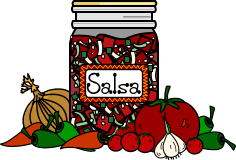
List of New Mexican recipe terms
The majority of the following terms are borrowed from similar cuisine in Mexico
and Spain; Most of New Mexican food is an imitation of Mexican food albeit with
the New Mexican standardized green chile, and some minor stylistic differences
that are also found in the northern Mexican states.
Albondigas: meatballs.
Bizcochitos: an anise-flavored cookie.
Burrito: a small-to-medium white flour tortilla, filled with meat, beans, cheese,
salsa, or a combination of these, and rolled.
Caldillo: (Green chile stew) a thin stew (or soup) of meat (usually beef, often
pork or a mixture), potatoes, and green chiles.
Capirotada: a raisin and walnut pudding.
Carne adovada: cubes of pork that have been marinated and cooked in red chile,
garlic and oregano.
Chalupa: a corn tortilla, fried into a bowl shape and filled with shredded
chicken or other meat, and/or beans, and usually topped with guacamole and salsa.
Chicharrones: small pieces of pork rind with a thin layer of meat that are deep-fried.
Chile or chile sauce: A sauce made from red or green chiles by a variety of
recipes, and served hot over many New Mexican dishes. Green chile is
made with chopped roasted chiles, while red chile is made with
chiles dried and ground to a powder (or pureed in a blender). Chile is one of
the most definitive differences between New Mexican and other Mexican and
Mexican-American cuisines. New Mexican cuisine uses chile sauce as taco
sauce, enchilada sauce, burrito sauce, etc. (though any given meal may use both
red and green varieties for different dishes).
Chiles: Peppers of the capsicum species. The New Mexico chile is a local cultivar
of the species, or subspecies otherwise represented as Anaheim peppers. The large,
flavorful New Mexican variety gives the region's cuisine much of its distinctive
style, and used so extensively that it is known simply as "chile". Green chiles
are those that are picked unripe; they are fire-roasted, then peeled before
further use. Unlike the ultra-mild canned supermarket green chiles, New Mexico
green chiles can range from mild to (occasionally) hotter than jalapeños, and
come in grades of spiciness at markets that cater to chile aficionados. The
climate of New Mexico tends to increase the capsaicin levels in the chile
compared to other areas. Red chiles are the ripe form of the same plant
(though particular strains are bred for intended use as red or green chile).
Generally more piquant than green chiles, they too can be roasted, but are
usually dried; they can be added whole, to spice an entire stew, or more often
are ground into powder or sometimes flakes. Freshly dried red chiles are sold
in string-bound bundles called ristras, which are a common decorative sight on
porches and in homes and businesses throughout the Southwest. Chiles may be
referred to as chile peppers, especially if the sentence requires them to be
distinguished from the chile sauce made out of them. The bulk of, and allegedly
the best of, New Mexico chiles are grown in and around Hatch, in southern New
Mexico. Chimayo in northern New Mexico is also well known for its chile peppers.
Chile con queso: chile and melted cheese mixed together into a dip. (Not to be
confused with chili con queso, which is Tex-Mex-style chili con carne stew
topped with cheese); 'chile' and 'chili' are pronounced slightly differently by
knowledgeable English speakers in New Mexico, especially if the difference would
be semantically important; the prononuciation of 'chile' leans at least slightly
toward the Spanish source, e.g. "chillay", at least when necessary.)
Chiles rellenos: whole green chiles stuffed, dipped in an egg batter, and deep
fried.
Chimichanga: a small deep-fried meat and (usually) bean burrito, also containing
(or smothered with) chile sauce and cheese; Chimichangas, like flautas and
taquitos, are a fast-food adaptation of traditional dishes in a form that can
be stored frozen and then quickly fried as needed; they are also rigid and
easily hand-held, and thus easy to eat by people while walking or driving.
Chorizo: a spicy pork sausage, seasoned with garlic and red chile, usually used
in ground or finely chopped form as a breakfast side dish or quite often as an
alternative to ground beef or shredded chicken in other dishes; New Mexican
chorizo is said to be noticeably different in its spice blend from that of
Mexico and California.
Cilantro: a pungent green herb (also called Mexican or Chinese parsley, the
seeds of which are known as coriander) used fresh in salsas, and as a topping
for virtually any dish; not common in traditional New Mexican cuisine, but one
of the defining tastes of Santa Fe style.
Empanada: a small, sweet, fruit or meat turnover.
Enchiladas: corn tortillas filled with meat, and/or cheese, and either rolled,
or stacked, and covered with chile sauce and cheese. The stacked version is
called a flat enchilada and is usually covered with either red chile sauce or
green chile sauce, and optionally topped with a fried egg. In California-style
Mexican-American food, enchiladas are invariably each a discrete item; New
Mexico-style enchiladas are often prepared fused together on a pan, assembled
and placed in the oven, or in a casserole dish and tend to be served in a manner
reminiscent of lasagna, though the California style is becoming more common,
especially in upscale restaurants geared toward those unfamiliar with the local
cooking style. Flat enchiladas made with blue-corn tortillas are a particularly
New Mexican variation.
Flan: a caramel custard
Flauta: a small, tightly rolled, fried enchilada; contrast chimichangas and taquitos.
Frijoles: beans, pinto beans (along with chile, one of the official state vegetables).
Green chile stew: same as Caldillo.
Guacamole: mashed, spiced avocado, usually with chopped onion, tomatoes, garlic,
lime and chile.
Horno: an outdoor, beehive-shaped oven ubiquitous in Pueblo communities.
Huevos rancheros: traditionally, eggs poached in chile. The modern dish is
typically fried eggs (sunny-side up or over-easy) covered with a hot green chile
or red chile sauce, or, occasionally, green chile stew.
Jalapeño: a small, fat chile pepper, ranging from mild to painfully hot, frequently
used chopped (fresh) in salsa, sliced (pickled) on nachos, or split (fresh) and
stuffed with cheese (outside of New Mexico, cream cheese is more common). Jalapeños
are common to all Mexican and Mexican-American cuisines. Their use in New Mexican
food tends to be lesser, in favor of green chile; they are used mainly to provide
additional piquancy when desired, though the heat of the chile used often renders
them unnecessary.
Oregano: A flavorful herb used in many cuisines, and most closely associated with
Italian food. Its heavy use in American cuisine in general has supplanted the use
of the unrelated but somewhat similar Mexican oregano spice in New Mexican (as well
as Californian and Tex-Mex) cuisine, though some cooks prefer to use Mexican
oregano, which remains easily obtainable in New Mexico.
Pico de gallo: cold salsa with thick-chopped fresh chiles, tomatoes, onions and
cilantro (does not have a tomato paste base like commercial packaged salsas, and
never any vinegar); the name, curiously, means "rooster's beak."
Posole: a thick stew made with hominy corn simmered for hours with pork and green
chile plus other vegetables such as onions and garlic. Red chile and chicken
recipes also exist, but are not traditional. The heavy use of New Mexico-style
green chiles makes this posole quite different from the ancestral Mexican variant.
Salsa: generally an uncooked mixture of chiles/peppers, tomatoes, onions, and
frequently blended or mixed with tomato paste to produce a more sauce-like texture
than pico de gallo; usually contains vinegar in noticeable quantities (contrast
chile and pico de gallo). The green chile variant usually uses cooked tomatillos
instead of tomatoes or omits both, and does not use avocado (which is very common
in California green salsa). The word simply means "sauce" in Spanish.
Salsa picante or picante sauce: A thin, vinegary, piquant (thus its name) sauce of
pureéd red peppers and tomatoes with spices, reminiscent of a combination of New
Mexico-style chile sauce and Louisiana style tabasco pepper sauce. (
Sopaipilla: a puffed, fried bread, that is eaten split or with a corner bitten
off and filled with honey or sometimes honey-butter (as accompaniment in place
of tortillas, or as a dessert), or sometimes stuffed with meat, beans, cheese
and chile sauce. Traditionally (and still in the north) served with soups (sopa
in Spanish) like posole and menudo, today sopaipillas are sometimes found stuffed
(like burritos) and are almost universally served as a dessert with honey.
Taco: a corn tortilla fried into a trough shape and filled with meats, cheese,
or beans, and fresh chopped lettuce, onions, tomatoes and cheese; increasingly
may also refer to the burrito-like uncooked, rolled flour tortilla variant, by
way of the influence of Taco Bell and its popularization of the California-style
"soft taco". A corn tortilla is always fried in New Mexico cuisine if to be used
in a taco.
Tamale (properly tamal in Spanish; plural tamales): meat rolled in cornmeal dough,
wrapped traditionally in corn husks (paper is more common today), and steamed,
and served most often with red chile sauce. New Mexican tamales typically vary
from other tamale styles in that red chile powder is almost always blended into
the masa.
Taquito or taquita: a tightly rolled, deep-fried variant of the taco; contrast
chimichangas and flautas.
Tortilla: a flatbread made predominantly either of unbleached white wheat flour
or of cornmeal.
Tostada: A corn tortilla that is fried flat and covered with meat, lettuce and
cheese. An open-faced taco.
Source: http://en.wikipedia.org/wiki/New_Mexican_cuisine
 


|
|